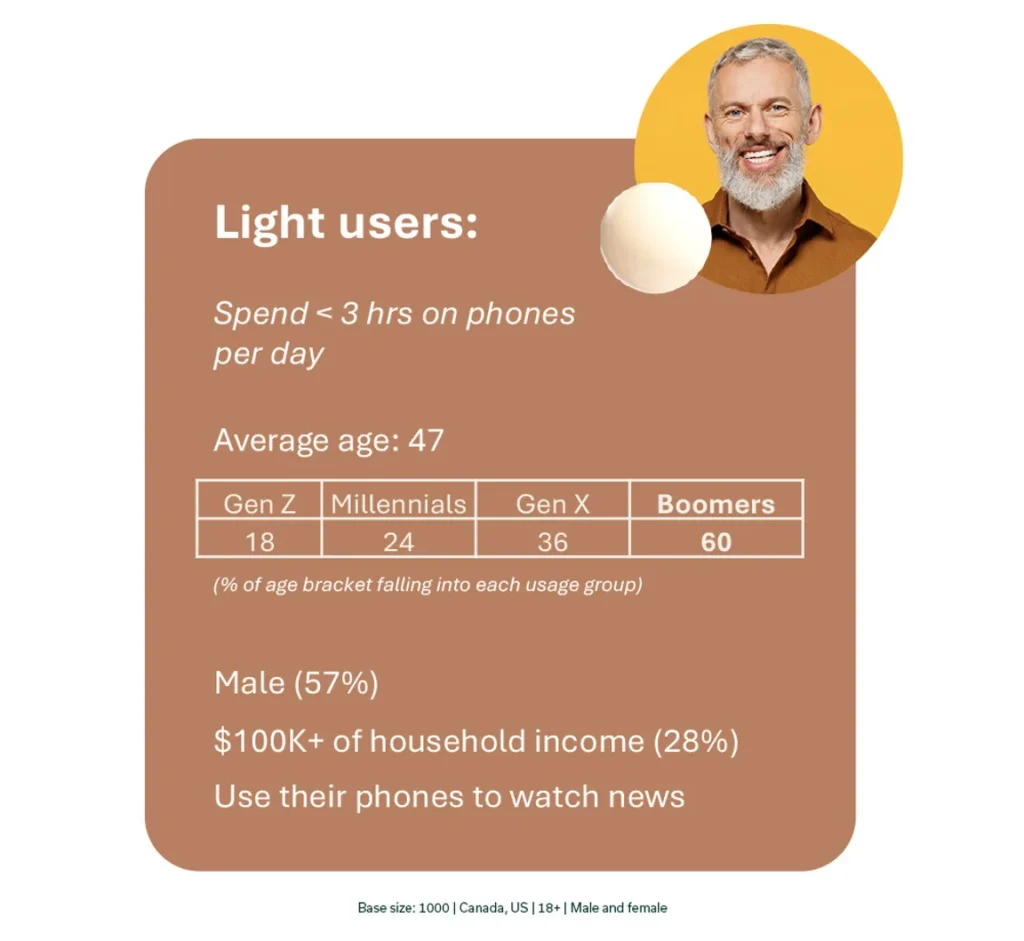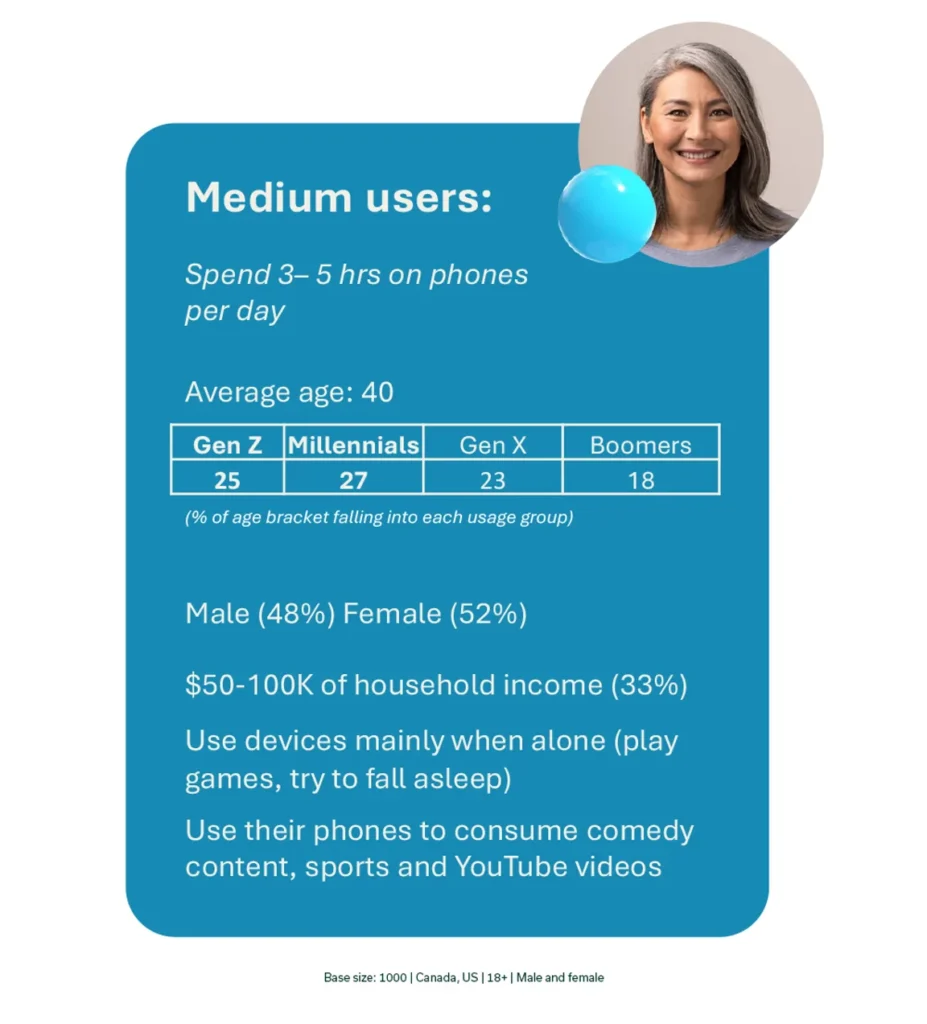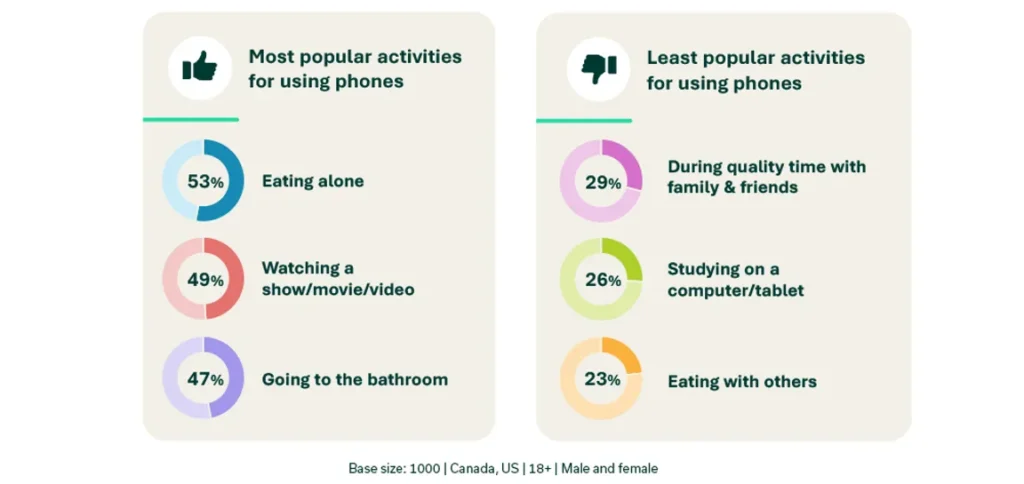Reading this blog title, you might be thinking that this article is going to be about the evils of using phones all the time or how we are sucked into our devices 24/7.
Well, rest assured, this article is the total opposite. In fact, it’s about how multitasking with your devices is totally okay, and it actually creates a fascinating environment for brands in today’s world. And it’s all based on a brand-new study we conducted with North Americans.
Before we begin, let’s set the stage:
- 88% of Canadians and 85% of Americans own smartphones
- About 75–85% of North Americans use a desktop or laptop computer, while about 50% own a tablet
These numbers show that consumers today are pretty used to being on multiple devices daily. We adapt our lifestyles to go along with this multi-device trend too.
Statistically, an average adult spends 30% of their time media-multitasking (i.e. switching between different content on different devices) or using a second screen.We know that 95% of consumers hold their smartphones while watching TV, and 81% of students multitask while doing homework. So yes, we multitask a lot.
But the reality is that our brains weren’t actually built to multitask. Just 2.5% of people can multitask effectively. And information is usually held in short-term memory for 30 seconds max before being discarded.
This shift towards multitasking and multi-device usage caused something called the Distraction Epidemic – the sociocultural change where overstimulation by technology and media drives us to lose focus on tasks and activities. It’s the truth of modern life.
So, what does it all mean?
It means that brands and advertisers are going through a hard time engaging consumers in a digital landscape. Before they can begin engaging with their audience and make them tap that “buy” button, brands need to break through the noise and somehow make sure that they build up equity in your mind in an increasingly challenging climate.
In other words, brands are desperately trying to navigate distraction.
The study
Knowing that distraction is basically part of our life today, we wanted to understand 3 things:
- The “how”: How do North Americans use their devices today?
- The “why”: Why do they get distracted?
- The “what”: What can brands do to navigate distraction?
In this article, we’re going to discuss the “how” and the “why”. And to answer the last point (the “what”), we decided to use our innovation insights platform Upsiide.
Here are some details about the study:
- Base size: 2000
- Canada, US
- 18+
- Male and female
- Smartphone owners
How do consumers engage with their phones and other devices?
How much time people spent on devices
It’s no surprise that smartphones occupy a huge part of our day compared to other devices. When we asked North Americans to tell us which device they use the most, 43% indicated that they use their phone for 5 or more hours a day(that’s a lot of scrolling Instagram).
In comparison, only 26% said that they watch TV for the same amount of time – in fact, most people spend about 2-3 hours in front of the TV screen.
It’s interesting that the US has a more significant proportion of heavy phone users (that is, people who use phones for more than 5 hours a day). About 51% of Americans comprise this group, compared to 36% of Canadians.
Key user groups
We wanted to see what different usage groups look like. Below are the critical characteristics of heavy, medium and light users:



It’s visible that the older the person is, the lighter their usage is. So, light users lean toward people in their forties, whereas heavy users tend to be Gen Z-ers or millennials.
Their phone behavior progresses depending on the usage too. Light users use phones mainly to connect with the world around them (e.g. read the news). Medium users prefer using phones to pass their “alone time” (e.g., play games or try to fall asleep). And heavy users like using phones in social and non-social situations (e.g. eating with others).
It’s important to note that people that use their phones a lot are also likely to use other screens a lot. So, if you use the phone for more than 5 hours a day, you probably also use your computer, tablet or TV for the same amount of time.
How people control their usage
Many people are actively trying to take steps to manage their phone usage.
43% use a screen time monitor on their phone, and about a quarter use a screen time limit on apps. Gen Z and millennials especially tend to put time controls in place, meaning that these consumers are especially attuned to their relatively heavy usage.
Social media consumption is evidently something people try to manage: the top apps people put a limit on are Facebook, Instagram and Youtube.
Why do consumers engage with phones over other things?
It looks like people reach for their phones to fulfil social needs.

North Americans spend the most time on their phones when they are alone and the least time when they are with others. Even though people usually reach for their phones to connect with others when they are alone, they prefer to keep their phones away if they already have company.
Where does the second screen come in?
Over 70% of consumers said they always or often use their phone while using another device. Almost half said they like to do that when watching a show/movie or while working/studying. And about 4 out of 10 said that they do that while using a computer/tablet for other reasons (e.g. reading the news, shopping, etc.).
As for what they’re doing on their phones while also using other screen devices, texting (62%), using social media (60%) and calling (47%) are among the top activities. Again, this aligns with our finding that people reach for more social connections.
Why do people reach for their phones?
After seeing the results, we can definitely conclude that the fear of missing out (FOMO) is a thing, even for phone usage.
Almost half of the respondents said that they check their phones “just in case” (i.e., to see if they missed anything). Just to shock you with another piece of data that we found online, an average American checks their phone at least 96 times a day, or (on average) once every ten minutes.
But another reason to check their phone is “exploring something I’ve seen on my other device” (41%). In this group, about 29% do that to look up information related to the content and 21% check or purchase products advertised in the program. So, if you’ve ever watched something on TV and wanted to check the actress’s name on your phone, you probably fall into this group.
Memory and multitasking
North Americans are pretty confident about their memory capacity and multitasking abilities. 35% of respondents said that they can remember content on both their phone and another screen device. And 4 out of 10 said that they can multitask with ease.
As we mentioned, multitasking isn’t something that our brains are accustomed to by nature, so it’s visible that consumers tend to overestimate their multitasking abilities since they live in a distraction-dominated world.
But why are they so confident? Well, it looks like people have embraced new methods of consuming content from all devices.
37% said that they always or often enable close-captioning, whereas 35% pause content on the screen to engage with other content on their phone. So because multitasking is hard for us, we learned to adapt our media consumption and, therefore, got better at doing things simultaneously.
So what are the key learnings?
- Multi-device usage is normal.
Consumers are engaging with multiple devices as a norm. Therefore, brands should expect that they’re communicating with a distracted audience.
2. Social engagement is the main driver for multi-screen usage.
People tend to use multiple screens for social engagement and to explore further what they’re experiencing on another device. So, prioritize presence on multiple devices to reinforce visibility.
3. Help audiences consume your content easily.
Consumers have learned to adapt their media consumption by using additional methods like close captioning or pausing content. Make your marketing materials (e.g. ads, messages or creatives) easily digestible and give people a variety of ways of digesting content.
Watch our event for more details
We discuss most of what we covered above in a recent event, Navigating Distraction: Second Screen Culture and How to Grab Shoppers’ Attention, led by our AVP, Gillian Geddie. Be sure to watch it if you want to see more about the insights we discovered.


